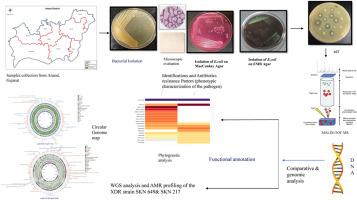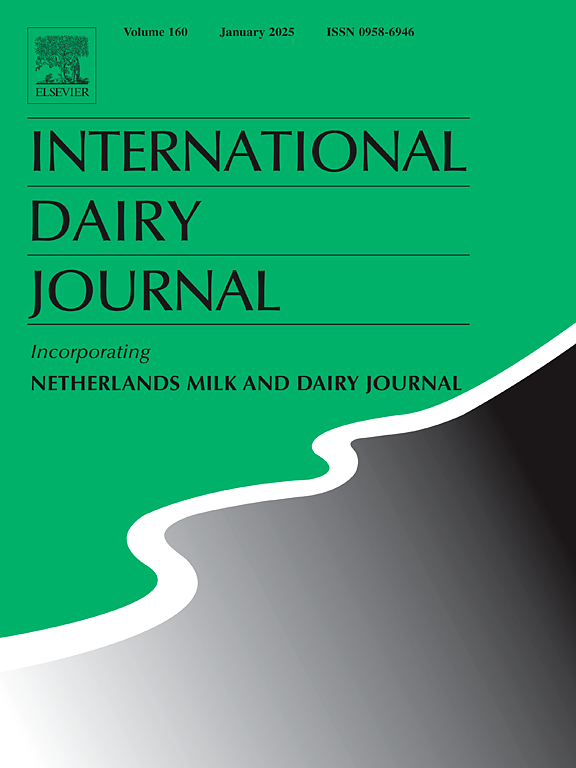Comparative genomic analysis of Multi-Drug Resistance and Virulence Determinants of Escherichia coliSKN 649 and Staphylococcus ureilyticusSKN 217 isolated and characterized from milk and milk products in Anand, Gujarat, India
IF 3.4
3区 农林科学
Q2 FOOD SCIENCE & TECHNOLOGY
引用次数: 0
Abstract
Antimicrobial resistance (AMR) in dairy-associated pathogens presents a significant public health and food safety concern. This study examined 100 raw milk and fermented milk (buttermilk) samples collected from cattle farms in Anand, Gujarat, India, between January 2022 and December 2023, to assess the AMR patterns and genetic determinants. The bacterial isolates were identified using selective culturing and MALDI-TOF mass spectrometry, and their antibiotic susceptibility was determined through standard testing methods. Whole-genome sequencing (WGS) was performed on two extensively drug-resistant (XDR) strains, Escherichia coli SKN 649 and Staphylococcus ureilyticus SKN 217, to elucidate key resistance genes and mechanisms. E. coli SKN 649 showed high resistance to multiple antibiotic classes, including β-lactams, aminoglycosides, and macrolides, while retaining sensitivity to tetracycline and chloramphenicol. S. ureilyticus SKN 217 exhibited similar resistance patterns, particularly against penicillin and cephalosporins, with 90 % of isolates showing resistance to multiple antibiotics. Genomic analysis revealed resistance mechanisms mediated by efflux pumps and target alterations, with major AMR genes identified, such as kdpE, vanG, rsmA, and emrB in E. coli and norC, salE, sepA, sdrM, vanT, and FusF in S. ureilyticus. These findings underscore the urgent need for genomic surveillance in dairy farming and highlight the potential transmission risks of AMR bacteria through the food chain. The misuse and overuse of antibiotics in the veterinary sector is a critical factor driving AMR, with implications that extend beyond dairy production to human health. This growing threat emphasizes the need for a One Health approach, linking human, animal, and environmental health to address AMR. The global spread of resistant pathogens underscores the necessity for stricter regulations, better antibiotic stewardship in veterinary practices, and continuous monitoring to prevent the further emergence of AMR strains. Future research should focus on developing effective control strategies and mitigating the global AMR threat to safeguard both public health and the sustainability of dairy farming.

印度古吉拉特邦阿南德地区牛奶和奶制品中大肠杆菌649和解脲性葡萄球菌skn217多药耐药和毒力决定因素的比较基因组分析
乳制品相关病原体的抗菌素耐药性(AMR)引起了重大的公共卫生和食品安全问题。本研究检查了2022年1月至2023年12月期间从印度古吉拉特邦阿南德的养牛场收集的100份原料奶和发酵乳(酪乳)样本,以评估抗菌素耐药性模式和遗传决定因素。采用选择性培养和MALDI-TOF质谱法对分离菌株进行鉴定,并采用标准检测方法测定其药敏。对2株广泛耐药(XDR)菌株大肠埃希菌(Escherichia coli) skn649和尿毒葡萄球菌(Staphylococcus uilyticus) skn217进行了全基因组测序(WGS),以阐明关键耐药基因和机制。大肠杆菌SKN 649对β-内酰胺类、氨基糖苷类和大环内酯类等多种抗生素均表现出高耐药性,同时对四环素和氯霉素保持敏感性。脓毒杆菌skn217表现出类似的耐药模式,特别是对青霉素和头孢菌素,90%的分离株显示出对多种抗生素的耐药。基因组分析揭示了由外排泵和靶标改变介导的耐药机制,并确定了主要的AMR基因,如大肠杆菌中的kdpE、vanG、rsmA和emrB,以及链球菌中的norC、salE、sepA、sdrM、vanT和FusF。这些发现强调了在奶牛养殖中进行基因组监测的迫切需要,并强调了AMR细菌通过食物链传播的潜在风险。兽医部门滥用和过度使用抗生素是推动抗生素耐药性的一个关键因素,其影响超出了乳制品生产,影响到人类健康。这一日益严重的威胁强调需要采取“同一个健康”方针,将人类、动物和环境卫生联系起来,以解决抗生素耐药性问题。耐药病原体的全球传播突出表明,有必要制定更严格的法规,在兽医实践中更好地管理抗生素,并进行持续监测,以防止AMR菌株的进一步出现。未来的研究应侧重于制定有效的控制策略和减轻全球抗菌素耐药性威胁,以保障公众健康和奶牛养殖的可持续性。
本文章由计算机程序翻译,如有差异,请以英文原文为准。
求助全文
约1分钟内获得全文
求助全文
来源期刊

International Dairy Journal
工程技术-食品科技
CiteScore
6.50
自引率
9.70%
发文量
200
审稿时长
49 days
期刊介绍:
The International Dairy Journal publishes significant advancements in dairy science and technology in the form of research articles and critical reviews that are of relevance to the broader international dairy community. Within this scope, research on the science and technology of milk and dairy products and the nutritional and health aspects of dairy foods are included; the journal pays particular attention to applied research and its interface with the dairy industry.
The journal''s coverage includes the following, where directly applicable to dairy science and technology:
• Chemistry and physico-chemical properties of milk constituents
• Microbiology, food safety, enzymology, biotechnology
• Processing and engineering
• Emulsion science, food structure, and texture
• Raw material quality and effect on relevant products
• Flavour and off-flavour development
• Technological functionality and applications of dairy ingredients
• Sensory and consumer sciences
• Nutrition and substantiation of human health implications of milk components or dairy products
International Dairy Journal does not publish papers related to milk production, animal health and other aspects of on-farm milk production unless there is a clear relationship to dairy technology, human health or final product quality.
 求助内容:
求助内容: 应助结果提醒方式:
应助结果提醒方式:


